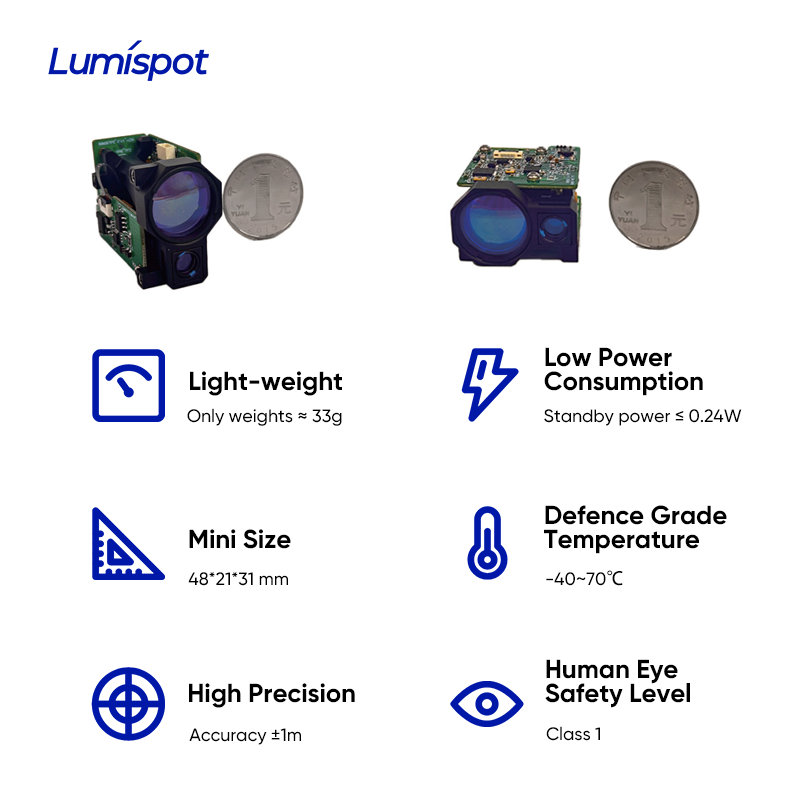1. Eye Safety: The Natural Advantage of the 1535nm Wavelength
The core innovation of the LumiSpot 0310F laser rangefinder module lies in its use of a 1535nm erbium glass laser. This wavelength falls under the Class 1 eye safety standard (IEC 60825-1), meaning that even direct exposure to the beam poses no harm to the retina. In contrast to traditional 905nm semiconductor lasers (which require Class 3R protection), the 1535nm laser requires no additional safety measures in public deployment scenarios, significantly reducing operational risk. Additionally, this wavelength exhibits lower scattering and absorption in the atmosphere, with up to 40% improved penetration in adverse conditions like fog, haze, rain, and snow—providing a solid physical foundation for long-range measurement.
2. 5km Range Breakthrough: Coordinated Optical Design and Energy Optimization
To achieve a 5km measurement range, the 0310F module integrates three key technical approaches:
① High-Energy Pulse Emission:
Single pulse energy is increased to 10mJ. Combined with the high conversion efficiency of the erbium glass laser, this ensures strong return signals at long distances.
② Beam Control:
An aspheric lens system compresses the beam divergence to ≤0.3 mrad, preventing energy loss from beam spread.
③ Optimized Receiving Sensitivity:
The APD (avalanche photodiode) detector, paired with a low-noise circuit design, enables precise time-of-flight measurements even under weak signal conditions (with a resolution of up to 15ps).
Test data shows a range error within ±1m for 2.3m × 2.3m vehicle targets, with a detection accuracy rate of ≥98%.
3. Anti-Interference Algorithms: System-Wide Noise Reduction from Hardware to Software
Another standout feature of the 0310F is its robust performance in complex environments:
① Dynamic Filtering Technology:
An FPGA-based real-time signal processing system automatically identifies and filters out dynamic interference sources such as rain, snow, and birds.
② Multi-Pulse Fusion Algorithm:
Each measurement emits 8000–10000 low-energy pulses, with statistical analysis used to extract valid return data and minimize jitter and noise.
③ Adaptive Threshold Adjustment:
Signal trigger thresholds are dynamically adjusted based on ambient light intensity to prevent detector overload from strong reflective targets like glass or white walls.
These innovations enable the module to maintain a valid data capture rate above 99% in conditions with up to 10km visibility.
4. Extreme Environment Adaptability: Reliable Performance from Freezing to Scorching Conditions
The 0310F is designed to withstand harsh temperatures ranging from -40°C to +70°C through a triple-protection system:
① Dual-Redundant Thermal Control:
A thermoelectric cooler (TEC) works in tandem with passive heat dissipation fins to ensure fast cold-start capability (≤5 seconds) and stable operation at high temperatures.
② Fully Sealed Nitrogen-Filled Housing:
IP67-rated protection combined with nitrogen filling prevents condensation and oxidation in high-humidity environments.
③ Dynamic Wavelength Compensation:
Real-time calibration compensates for laser wavelength drift due to temperature changes, ensuring measurement accuracy across the full temperature range.
Third-party tests confirm that the module can operate continuously for 500 hours without performance degradation under alternating desert heat (70°C) and polar cold (-40°C).
5. Application Scenarios: Enabling Cross-Sector Use from Military to Civilian Fields
Thanks to SWaP (Size, Weight, and Power) optimization — weighing ≤145g and consuming ≤2W — the 0310F sees widespread application in:
① Border Security:
Integrated into perimeter monitoring systems for real-time tracking of moving targets within 5km, with a false alarm rate of ≤0.01%.
② Drone Mapping:
Covers a 5km radius per flight, delivering 5x the efficiency of traditional RTK systems.
③ Power Line Inspection:
Combined with AI image recognition to detect transmission tower tilt and ice thickness with centimeter-level accuracy.
6. Future Outlook: Technical Evolution and Ecosystem Expansion
LumiSpot plans to launch a 10km-class rangefinder module by 2025, further solidifying its technical leadership. Meanwhile, by offering open API support for multi-sensor fusion (e.g., RTK, IMU), LumiSpot aims to empower foundational perception capabilities for autonomous driving and smart city infrastructure. According to forecasts, the global laser rangefinding market is expected to exceed \$12 billion by 2027, with LumiSpot’s localized solution potentially helping Chinese brands capture over 30% of the market share.
Conclusion:
The breakthrough of the LumiSpot 0310F lies not just in its technical specifications, but in its balanced realization of eye safety, long-range accuracy, and environmental adaptability. It sets a new benchmark for the laser rangefinding industry and injects strong momentum into the global competitiveness of intelligent hardware ecosystems.
Post time: May-06-2025

